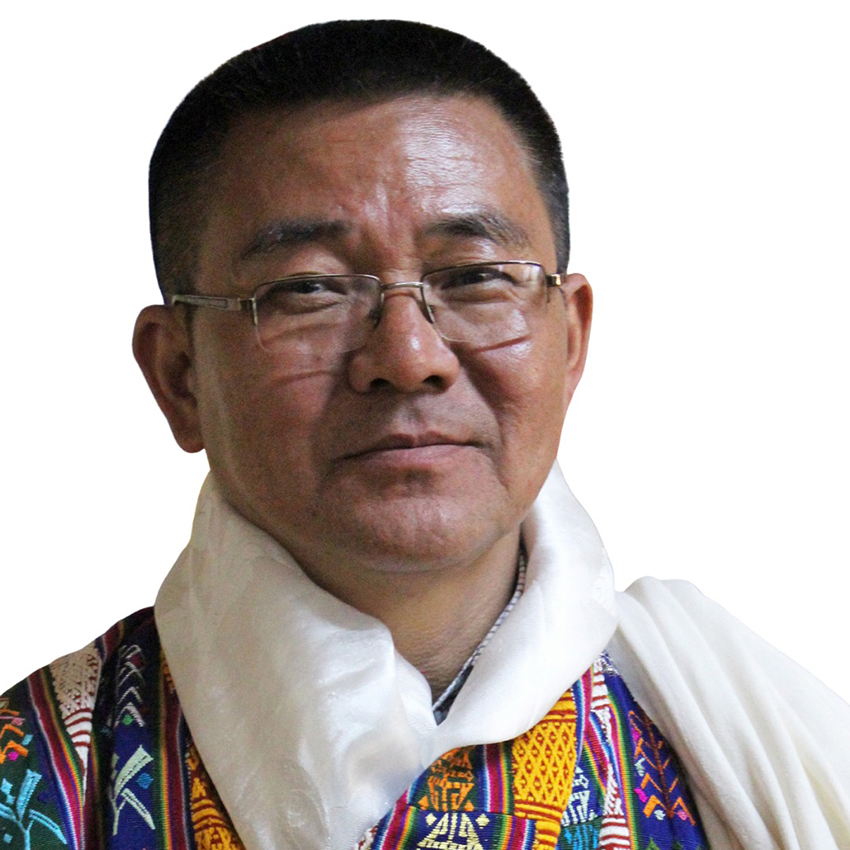Bhutan Is In Harmony With Nature, Well-Being and Sustainability Bhutan is keen to welcome Indians and increase the number of visitors through ease of travel, infrastructural developments and unique experiences


By Neha Mehrotra
Nestled amidst the eastern Himalayas, Bhutan has long been shrouded in mystique, unveiling its treasures to foreign tourists as recently as 1974. Its restrictive policies and distinctive approach to sustainability have preserved its pristine allure. As a result, Bhutan remains a sanctuary frozen in time, untouched by the mass tourism plaguing other destinations, and proudly boasts its status as one of the world’s first carbon-negative nations. By harmonising economic growth with a steadfast commitment to preserving its natural heritage, Bhutan sets a remarkable example for a greener future while safeguarding the welfare of its people and environment.
Drawing Indian tourists with its breathtaking landscapes, vibrant cultural heritage, and unparalleled hospitality, Bhutan continues to captivate hearts. In an exclusive conversation with PEAKLIFE, Dorji Dhradhul, Director General of Bhutan’s Department of Tourism, sheds light on the kingdom’s sustainability initiatives, major tourist attractions and more.
1. How important is the Indian market for Bhutan?
Dorji Dhradhul: India represents one of the fastest-growing outbound tourism markets in the world, so the majority of destinations see the value in wooing Indian tourists. Bhutan shares a long border with India, so it is naturally a very important strategic partner for us. We will work closely with Indian travel partners to continue to attract Indian guests, and we already see positive trends in this regard.
Moreover, there are many more Indians seeking mindful holidays post-whims. pandemic, as well as being more inclined to travel with family and explore local culture, Bhutan (being a short-haul destination from India) is very well positioned to leverage these trends. Currently, around 70% of all guests to Bhutan are from India.
2. What are some of the unique attractions that have proven to be particularly appealing to Indian tourists?
Dorji Dhradhul: Bhutan boasts a plethora of captivating attractions that beckon travellers from around the globe, including a significant number of Indian tourists. From majestic fortresses to serene monasteries, Bhutan offers a tapestry of experiences that cater to every traveller’s whims. From the grandeur of Punakha Dzong, nestled at the confluence of rivers, to the spiritual sanctity of Paro Taktsang, perched dramatically on a cliffside, each site offers a unique glimpse into Bhutanese culture and history. The Buddha Dordenma, overlooking Thimphu Valley, and Dochula Pass, with its symbolic stupas and panoramic vistas, further enrich the traveler’s journey, while the Thimphu Memorial Chorten serves as a poignant tribute to Bhutan’s monarchs and spiritual ethos.
Venturing deeper into Bhutan’s hinterlands, the Haa Valley and the biodiversity-rich Phobjikha Valley captivate with their lush meadows and abundant wildlife, providing sanctuary to migratory birds and intrepid travellers alike. In the heart of Bhutan lies Bumthang, often hailed as the ‘Switzerland of Bhutan,’ where cultural treasures such as the Swiss Cheese Factory and Red Panda Beer Factory offer tantalising glimpses into the nation’s artisanal heritage.’ Additionally, the village of Khoma in Lhuentse showcases Bhutan’s artisanal heritage through its intricate textiles and ancient monasteries.
3. Could you share some insights or initiatives to enhance the overall experience for Indian travellers?
Dorji Dhradhul: Bhutan is working towards enhancing the overall experience of visitors, including Indian travellers. There are huge investments being made at the national level in terms of upskilling our tourism and hospitality sectors, re-certifying our guides and accommodation providers, revamping the tourism infrastructure, and creating new and unique experiences for all our guests. We have also collaborated with our partners in the Bhutanese travel and tourism industry to work together to attract conscious travellers from around the world.
Bhutan has also invested in infrastructure and amenities to ensure the comfort and safety of travellers. From the development of eco-friendly accommodations to the establishment of well-maintained trekking trails and tourist facilities, these efforts are aimed at providing travellers with a seamless and enjoyable experience while minimising the impact on the environment.
Furthermore, we have also made changes to the way people can visit Bhutan, with the goal of making it easier and more accessible. In the past, all visitors needed to book their travel to and within Bhutan through an accredited tour operator. Any visitor travelling to Bhutan after our reopening on September 23, 2022, can now independently book all aspects of their journey. Still, we warmly recommend our many accredited tour operators and guides for their expert knowledge and excellent service.
4. What steps are you taking to make Bhutan a sustainable destination?
Dorji Dhradhul: In Bhutan, sustainable tourism is more than just a concept—it’s a way of life deeply ingrained in the country’s ethos. One pivotal initiative driving this commitment is the Sustainable Development Fee (SDF), a daily contribution from visitors that fuels a spectrum of sustainability endeavours. From supporting free healthcare and education to enhancing tourism infrastructure and preserving the environment and cultural heritage, the SDF stands as a cornerstone in Bhutan’s sustainable tourism model.
This fee also plays a vital role in upholding Bhutan’s pristine natural landscapes and carbon neutrality by offsetting visitors’ carbon footprints through initiatives like tree planting. Moreover, Bhutan’s High value, Low volume tourism policy ensures that conscious and responsible travellers are welcomed, ensuring exceptional experiences while safeguarding Bhutan’s values.
Furthermore, Bhutan is actively involved in a multitude of environmental and sustainability projects, like the Electric Vehicle (EV) Project and the Million Trees Project, launched in 2021, which aim to plant a million trees over the next five years, while the Zero Waste Bhutan initiative targets achieving zero waste by 2030 through effective source segregation and improved waste management service delivery.
Additionally, the five-year GEF (Global Environment Facility) ecotourism and biodiversity project under UNDP is being implemented by the Department of Tourism as part of the Tourism Flagship Programme and will cover two protected areas, Bumdeling Wildlife Sanctuary and Sakteng Wildlife Sanctuary, and five districts. It seeks to establish Bhutan as a leading ecotourism destination, integrating biodiversity conservation into tourism development while fostering sustainable livelihoods and mitigating negative impacts on socio-cultural heritage.
5. Lastly, what’s next?
As we move forward, our commitment remains steadfast to cherishing our values and inviting conscious travellers to join us on our journey. We are dedicated to enhancing our services and experiences and crafting unforgettable moments for our guests. Our relentless pursuit of excellence drives us to continually innovate, developing new products that resonate with the needs of our discerning visitors. With each step, we strive to exceed expectations while fostering sustainable practices.
More from our site
Recent Posts
Shaping Tomorrow’s Golf Champions With Leela Palace Bengaluru
The 3rd edition of The Leela Golf Tournament celebrated young talent and brought together skill, precision and camaraderie!
The 3rd edition of The Leela Golf Tournament celebrated young talent and brought together skill,…
The Duo Behind KAIA Goa & Gigi Bombay, Redefines Hospitality
In conversation with the founders of Pawan Shahri and Nikita Harisinghani, the duo behind Chrome Hospitality Asia
In conversation with the founders of Pawan Shahri and Nikita Harisinghani, the duo behind Chrome…
Precision, Durability, and Swiss Legacy
Victorinox launches the Swiss Army collection, featuring three distinct models that emphasise exceptional quality, resistance and versatility
Victorinox launches the Swiss Army collection, featuring three distinct models that emphasise exceptional quality, resistance…
A New Era of Luxury Interiors With Sussanne & Gauri Khan
Sussanne Khan & Gauri Khan unite to bring an awe-inspiring, six-storey sanctuary of luxury, art, and design in Hyderabad
Sussanne Khan & Gauri Khan unite to bring an awe-inspiring, six-storey sanctuary of luxury, art,…
Air India x Lufthansa: Fly To These International Destinations Now
Expanding their codeshare partnership, Air India and Lufthansa Group have added 100 new routes to their combined network
Expanding their codeshare partnership, Air India and Lufthansa Group have added 100 new routes to…
Luxury’s Most Recent & Vibrant Launches This Season
The luxury landscape is brimming with bold innovations, striking partnerships, and immersive experiences
The luxury landscape is brimming with bold innovations, striking partnerships, and immersive experiences
